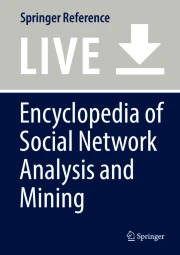
This is a preview of subscription content, log in via an institution to check access.
The Encyclopedia of Social Network Analysis and Mining (ESNAM) is the first major reference work to integrate fundamental concepts and research directions in the areas of social networks and application to data mining. This set of comprehensive and authoritative volumes
• explains the science and technology behind the rapidly growing global avenues for exchanging views and influencing others
• presents the first comprehensive coverage of all fields that contribute to social network construction and analysis as a multidisciplinary domain
• is designed to appeal to an interdisciplinary audience ranging from the undergraduate to professional level
• describes social network applications to knowledge mining and discovery
• addresses privacy, security, ethical, and civil liberty issues for social networks.
While ESNAM reflects the state-of-the-art in social network research, the field had itsstart in the 1930s when fundamental issues in social network research were broadly defined. These communities were limited to relatively small numbers of nodes (actors) and links. More recently the advent of electronic communication, and in particular on-line communities, have created social networks of hitherto unimaginable sizes. People around the world are directly or indirectly connected by popular social networks established using web-based platforms rather than by physical proximity.
Reflecting the interdisciplinary nature of this unique field, the essential contributions of diverse disciplines, from computer science, mathematics, and statistics to sociology and behavioral science, are described among the 300 authoritative yet highly readable entries. Students will find a world of information and insight behind the familiar façade of the social networks in which they participate. Researchers and practitioners will benefit from a comprehensive perspective on the methodologies for analysis of constructed networks, and the data mining and machine learning techniques that have proved attractive for sophisticated knowledge discovery in complex applications. Also addressed is the application of social network methodologies to other domains, such as web networks and biological networks.
Reda Alhajj is a Professor in the Department of Computer Science at the University of Calgary. He published over 350 papers in reputable journals and fully refereed international conferences. He served as program chair of several conferences and on the program committee of large number of International conferences including IEEE ICDE, IEEE ICDM, IEEE IAT, IEEE WI, SIAM DM, AAAI, IJCAI, etc. He also served as guest editor of several special issues and is currently the program chair of IEEE IRI 2011, CaSoN 2011, ASONAM 2011, IEEE HPPC 2011 and OSINT-WM 2011. He is on the editorial board of several journals; he associate editor of IEEE SMC- Part C. He is editor in chief of SNAM Journal and the Lecture Notes in Social Networks series by Springer. He frequently gives invited talks in North America, Europe and the Middle East. Dr. Alhajj's has a large research group which in 2010 had 10 PhD and 8 MSc students working primarily in the areas of biocomputing and biodata analysis, datamining, multiagent systems, schema integration and re-engineering, social networks and XML. He received Outstanding Achievements in Supervision Award from the Faculty of Graduate Studies at the University of Calgary. He closely collaborates with RBC Canada.He is married and has three daughters and two sons.
Jon Rokne is a Professor in the Department of Computer Science at the University of Calgary where he chaired the department from 1989 to 1996. He obtained an M. Sc. from the University of Alberta and a Ph. D. from the University of Calgary, both in the area of applied mathematics with a numerical analysis emphasis. His main applied mathematics interests have been interval analysis and global optimization and he has co-authored three books in these areas. In computer science the focus has been computer graphics and physically and biologically based computer simulations with publications on the visual simulation of leaves, auroras, sky, Chinese calligraphy, seismicvisualization and ball lightening. He has published one jointly authored computer science book entitled "Light Interaction with Plants". He has also published papers in the areas of computational geometry, computer-aided design and social networks. In 2009 and 2010 he was the publicity chair for ASONAM. His extracurricular activities have included skiing, hiking and mountaineering. He is married and his wife teaches in the Faculty of Education of the University of Calgary. He has two sons.